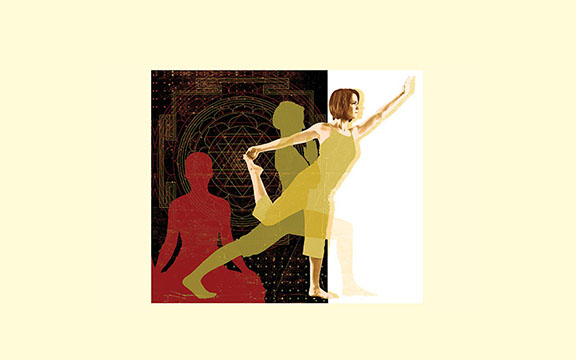 Michael Rhadeya Plasha (Yoga, Ayurvedic and meditation educator and an addiction, trauma and chronic disease specialist) has spent two decades refining his practice and teaching of Hatha Yoga while integrating Raja Yoga into the class. In this article he shares what inspired this approach and then gives an example of how we can take our Hatha practice to even deeper levels.
Michael Rhadeya Plasha (Yoga, Ayurvedic and meditation educator and an addiction, trauma and chronic disease specialist) has spent two decades refining his practice and teaching of Hatha Yoga while integrating Raja Yoga into the class. In this article he shares what inspired this approach and then gives an example of how we can take our Hatha practice to even deeper levels.
Hatha Yoga is a great practice for reducing the stress we store in our bodies. It might not, however, root out the cause of stress which is the mind. Raja Yoga roots out the cause of stress. If we don’t include a Raja Yoga foundation in our Hatha, then doing Hatha is like taking a “Yoga pill.” For example, you go to Yoga class, and after the class your body feels good. You get in your car to drive home and you get behind a slow driver and road rage comes out. We have to ask: What is our Yoga really doing for us? What can we bring into our awareness that helps us to be free from the root cause of stress? Can I become free of impatience on the mat—like getting restless in a forward bend—so I can become more patient off the mat?
Swami Satchidananda (Sri Gurudev) used to say, “Hatha Yoga is the calling card for Raja Yoga.” That’s what triggered it for me. A Hatha Yoga class, particularly in the Integral Yoga style, has a lot of covert Raja Yoga elements. I kept contemplating Gurudev’s words and asked myself, “How do I go deeper with this and how can I bring the yamas, niyamas, pratipaksha bhavana, and other aspects of Raja Yoga to my practice and teaching of Hatha Yoga?” This is how my teaching style evolved.
The sample class I will share with you is for the experienced practitioner. With new students, I’m mainly focusing on safety, alignment, and then I’ll briefly mention one yama or niyama per week. When I teach more experienced students, what I’m observing in the class will stimulate a connection with one or more of the sutras in Raja Yoga. I might ask the class to make a group intention such as dedicating our practice to svadhyaya: What can I learn about myself during this class? Or, we might select one of the yamas or niyamas to focus on throughout the class or a general virtue like acceptance, detachment or patience.
After the opening of the class, we begin the Sun Salutation:
“Let’s begin. Bring the palms together in anjali mudra as we take a moment to offer the fruit of our practice to something greater than ourselves. Remember that Hatha Yoga is not just about me, it’s about purifying my mind and body so that I can love and serve others better. This is the spirit of Bhakti and Karma Yoga. Today, to whom would you like to offer your practice?”
(I try to find a balance between talking to the class and having enough silence so that the students can go deeply into the practice).
“Come into virabadrasana (warrior pose). Feet are wide apart, turn right foot out parallel to mat, left foot rotates in 25 degrees. This is a strong pose. Feel your strength—inhale courage, exhale fear. Can a proud warrior practice ahimsa? Can we stand for what we believe in without harming others? Did Martin Luther King, Mahatma Gandhi, the Dalai Lama, Sri Gurudev do this? Can we do this? How do I practice ahimsa for myself on and off mat? Can I practice without strain? Can I not compromise the breath for the posture? Can I perhaps let go of the inner critic and not pay attention to any negative judgments about my practice. What can I let go of in order to be fearless?
“Let’s come into the trikonasana, the triangle pose. Notice: “Am I straining? Am I putting too much energy into the pose, can I relax a little? Or, do I need to accelerate the energy I’m putting through my arms, my spine?” Brahmacharya, one of the yamas, is about learning how to manage our energy wisely. One translation is celibacy; another is, moving toward a reconnection with the divine within. How we manage our energy might determine how we’ll experience that connection.
“Let’s rest in savasana before we move into the backward bending poses. As you relax in savasana, bring to mind the intention you made at the start of the class and reflect upon how you are experiencing it now. Please roll over onto the abdomen in advasana for the backward bending postures. Let’s explore aparigraha (non-greed). Can I reduce wants to needs? Am I free of desires? Do I desire my body to be something other than what it is on the Yoga mat? Do I ever feel I am taking more from my body than its willing to give me? Let’s be mindful of our tendency to strain, especially in back bends, which is also a form of greediness.
“All the backward bending postures are sacred and they open the heart space. Can I follow my heart in cobra pose? One way to practice satya, ahimsa, and aparigraha is to ignore me at any time during the class. I mean this from the bottom of my heart. The only thing you have to do in my class is to breathe—everything else is optional. If you come in and are tired or fatigued, feel free to do legs-up-on-the-wall pose or let me know and I‘ll put you in a restorative pose. Just because I’m directing you, you can listen to the wisdom of your body and honor that. There’s more Yoga in under-doing than overdoing sometimes so, please do what rings true to you.
“After resting in savasana, we move into the forward bending series of postures. Here is another opportunity to practice brahmacharya. Bring awareness to your energy and balancing the energy. In janushirshasana, can I increase the energy to feel more of a stretch here? Or, can I decrease the energy if I am straining? How do I do that in my daily life? Each moment on and off the mat, we have an opportunity to choose how we direct our energy. We know we are directing toward our connection to the divine, if it leads to eternal joy rather than temporary pleasure. If the mind wanders, can I direct it back to the breath—breathing in and out of sensation where I feel it the most—and be the witness of the mind, breath and body?
“Santosha in the full forward bend is feeling contentment with where you are in the pose. Some Yoga masters feel that contentment is the highest practice: accepting reality as it is rather than what we want it to be. If I look at someone else in the class and their chest is on their shins and I am vertical, do I judge myself? A beautiful Raja Yoga balance is tapas—the effort to do the pose, balanced with santosha, accepting where you are in the process. Tapas is what got you out of bed, got you to work, got you here, God bless you! You made it! Now relax into paschimotanasana.
“Let’s come into sarvangasana or shoulder stand. This and headstand are good poses to practice Ishvara pranidhana, surrender to the divine. How does it feel to be upside down? Can I be comfortable in the unknown? Can I be comfortable when I feel like my life has turned upside down? Can I surrender to what the universe is bringing me right now? Do I ever feel the weight of my world is on my shoulders from too much tapas? Before I come out of shoulder stand, can I let go of what I’m holding in my shoulders and perhaps give some over to the divine helper?
“Matsyasana, the fish pose is next and it’s the perfect posture to practice saucha. In this pose, we can purify our hearts and minds with the chest open and with deep breathing. Can I let go of anything I’m holding in my heart area that prevents me from having a pure heart and pure intentions? Do I need to modify or adjust this posture so it feels more pure to me?
The next posture is the spinal twist. In this pose we can utilize svadhyaya to ask ourselves: What am I learning about myself right now? We can be sensitive to how much energy we are putting into this pose. Can I go down to go up and find the balance between descending and ascending energy? Can I find the balance between receiving support and making an effort? Can I be comfortable when I feel like life is twisting me into a place of stress and tension? Can I practice satya and be clear with my intention and speak my truth so I can avoid being involved in twisted communications and relationships? Who am I?
“Now as we come into Yoga Mudra, we can continue to practice saucha. Ideally Hatha Yoga purifies the mind and body and prepares it for meditation. Do I feel a little more purified by my practice? Now, bring to mind the intention you made at start of class, and notice how you experience it now.
Yoga Nidra (deep relaxation) would follow as usual. “Next is our pranayama practice. This is a great practice to support the Raja Yoga practice of saucha, purifying the mind and body. Deerga swasam calms, kapalabhati clears, and nadhi suddhi purifies and focuses the mind for meditation. Patanjali says the ultimate pranayama destroys the veil that covers the spiritual light within. This could be the ultimate practice of saucha. A pure diet is good, lentil soup is good, but I want something to destroy the veil!
We end the class with meditation, OM, and universal peace chants. “Please bring palms together in front of the heart as we take a moment to bow to our hearts, and to our worthiness, completeness, and greatness, and to the light within and within each other. Namaste.”
 About the Author:
About the Author:
Michael Rhadeya Plasha, E-RYT 500, RPYT, has been studying classical Yoga since 1971 years and has taught over 12,000 classes. He is a senior Integral Yoga teacher, certified in Integral Yoga Levels 1 and 2, Prenatal Yoga, and Yoga of the Heart. He leads workshops for teacher trainings and the general public, presents for teachers at conferences and is director of the Plasha Yoga School. For more information please visit: www.plashayoga.com.

